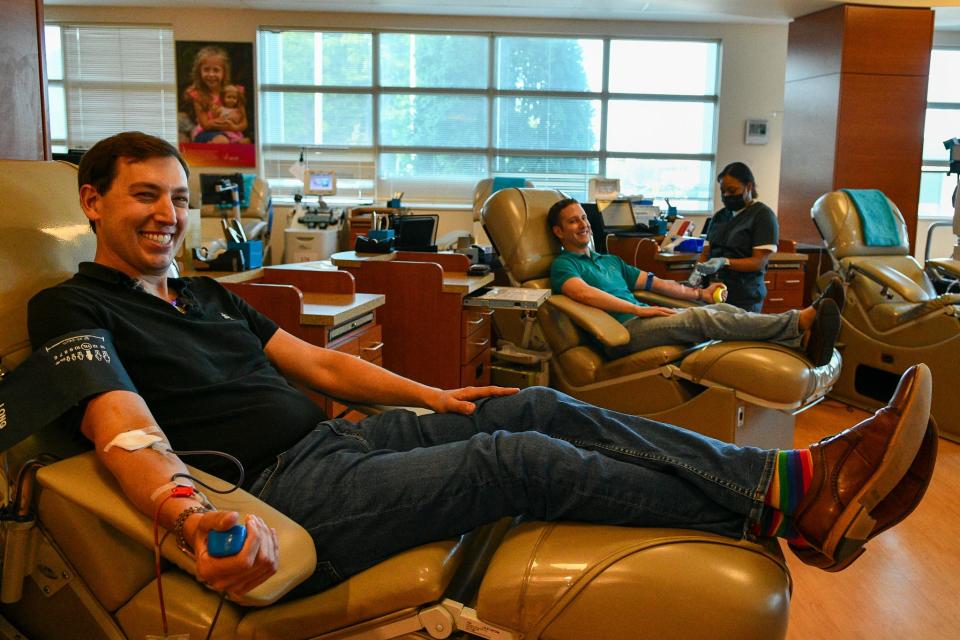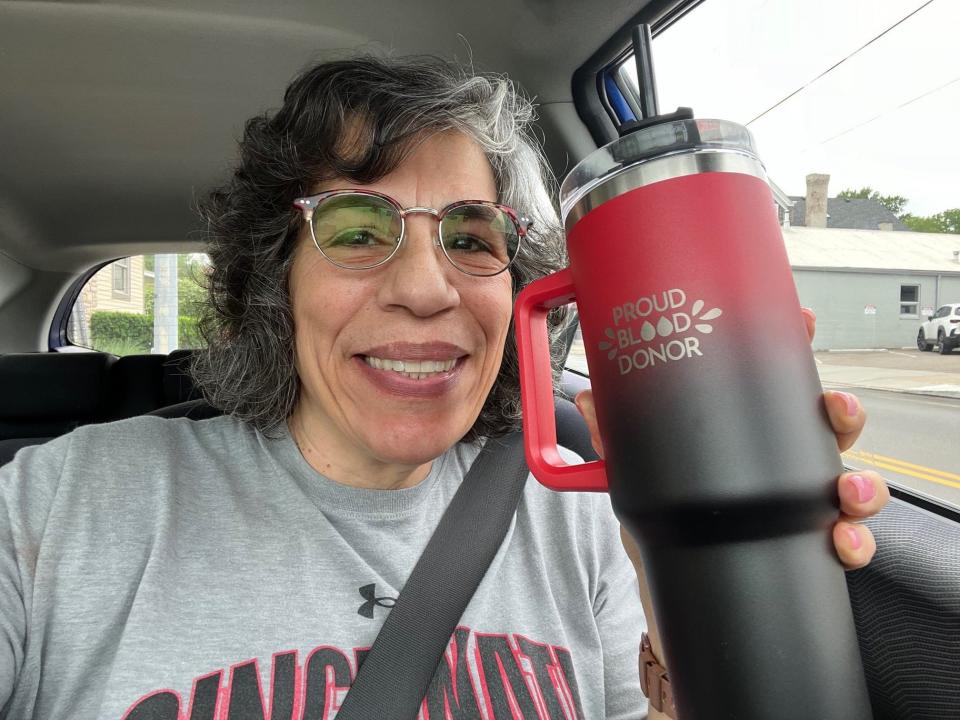Donating blood makes my skin look great. Giving blood is good for you.
I love to give blood. It is one of life’s most pleasant activities: 100% indulgence, self-care, a spa treatment.
As for a spa, I go regularly, every 56 days or so, for about an hour. In the spotless venue, yacht rock floats on the sound system; in the air, a light tang of isopropyl alcohol. A cheerful team member pampers me. I take the treatment, I relax with juice and cookies, then I’m on my way.
Giving blood is so great, it ought to have a cool subculture, with anime or a Netflix series. But such celebration requires an activity to be at least a little popular already. And giving blood is definitely not.
Last year, only 6.8 million Americans gave blood once. That’s 3% of the U.S. population eligible by age. The trend is uglier. The American Red Cross says that in the past 20 years, donorship has fallen by 40%.
An entire generation has never known the delights. It’s as if giving blood has been actively discouraged, like sex and drugs and rock ‘n’ roll. The time has arrived to open minds. June 14 is World Blood Donor Day, so consider me your Merry Prankster through the gates of perception: Giving blood is good for you.
How to give blood And frequently asked questions about blood donations
Why should I give blood?
Giving blood feels like magic because for most of human awareness, blood was magic. We spilled it, we drank it, we painted our faces with it. We wrote messages in blood, usually misspelled.
Then one night in England in 1818, everything changed. A woman was dying from blood loss after childbirth. Her desperate doctor drew blood from her husband and injected it into her. She lived.
That transfusion turned blood from magic into something more -- knowledge.
In the next 200 years, we learned to type blood, to bank it, to ensure its safety, to ship it, to give it to the right person, and to make giving blood feel a visit to a spa.
I’ll never forget my first time. I was nervous but curious. I shed my inhibitions to bare my arm, and I was transformed. Then my donor card arrived with stunning news. My blood type is AB negative, the rarest, the 1%, like the billionaire 1%. When I show up to give, I get a billionaire’s welcome, everyone a-flutter, hello, thank you for visiting, please sit here, we validate parking.
Giving blood doesn’t melt my stubborn belly flab. But over the 56 days that my body replaces that pint, I burn 500 calories, no extra exercise. That is one plain glazed doughnut.
Is giving blood good for you?
Research shows that giving blood has an antioxidant effect. It can reduce chemicals that produce inflammation. And get this: Giving blood improves the skin tone of mice. My spa treatment also floods my brain with dopamine because I am thinking about that plain glazed doughnut in my future.
Plus, in giving blood, I get a lesson in supply and demand. Americans are in terrible health and need a lot of blood, often more than is available. Hospitals buy blood from the Red Cross and other collection organizations and pay on average $634 a pint. That spiraling cost gets baked into insurance premiums, deductibles and out-of-pocket costs. Medicare covers three pints of blood, but if I need more, that’s on me.
All community service should be like giving blood: a tiny, personal cost for direct, instant gratification. I don’t get money to give blood. I get free branded stuff. My collection includes 27 T-shirts marking major holidays, local sports teams, even the cicada emergence; six travel mugs; three throw blankets; three water bottles; two beach towels; two scarves; two half-zip sports shirts; one pair of flannel pajama bottoms; a knee-length fleece hoodie; a windbreaker, and the piece de resistance, a barbecue set.
One year, Hoxworth Blood Center in Cincinnati raffled off a red Mini Cooper. No magic here; I did not win. I took comfort in my barbecue set.
Only once did I consider not giving blood anymore, when the blood center stopped serving plain glazed doughnuts after donation. I settled for the juice and cookies, but I moped about that. Then 56 days later, I rolled back in with a billionaire’s swagger that my itsy-bitsy contribution holds up the entire edifice.
Yet here’s the delicious irony. Like the billionaire 1%, the AB negative 1% is nearly useless. I can take blood from anyone. But almost no one can take mine. The real work gets done by all those strong, silent O negatives, whose blood can go to everyone.
In part, the decline in donors was a factor of the COVID-19 pandemic, since working from home wiped out blood drives in workplaces and high schools. And only last year did the government lift the donation ban on all gay men, imposed 35 years ago to stop HIV transmission.

Blood donation policy is updated allowing gay and bisexual men to give
Does it hurt to give blood?
But a 40% drop in donors over 20 years testifies to the one thing that spreads faster than a virus: fear.
People fear the sight of blood. But come on, that burgundy is gorgeous. I want a pair of suede boots in that color.
People also fear they’ll faint. So eat the doughnut before giving blood. And add some protein.
And people fear needles. Yet every year, millions get tattooed from metacarpal to clavicle, and a blood-donation needle never leaves regret. It’s a means to a barbecue set – and something more.
Not long ago, I arrived for my spa treatment, the Big One Percenter, and the cheerful team member said hello, the NICU just called looking for you.

No, I said. Me? Are you sure? Yes, she replied. We give your platelets and plasma to the preemies.
I rolled up my sleeve marveling that every 56 days, thanks to this AB negative, some very sick babies got strong, and went home, and grew up. Later, with my juice and cookies, I knew at last why I love to give blood.
I’m someone’s magic.
Anne Saker is a writer in Cincinnati and an 18-gallon blood donor.
This article originally appeared on USA TODAY: Why you should donate blood


